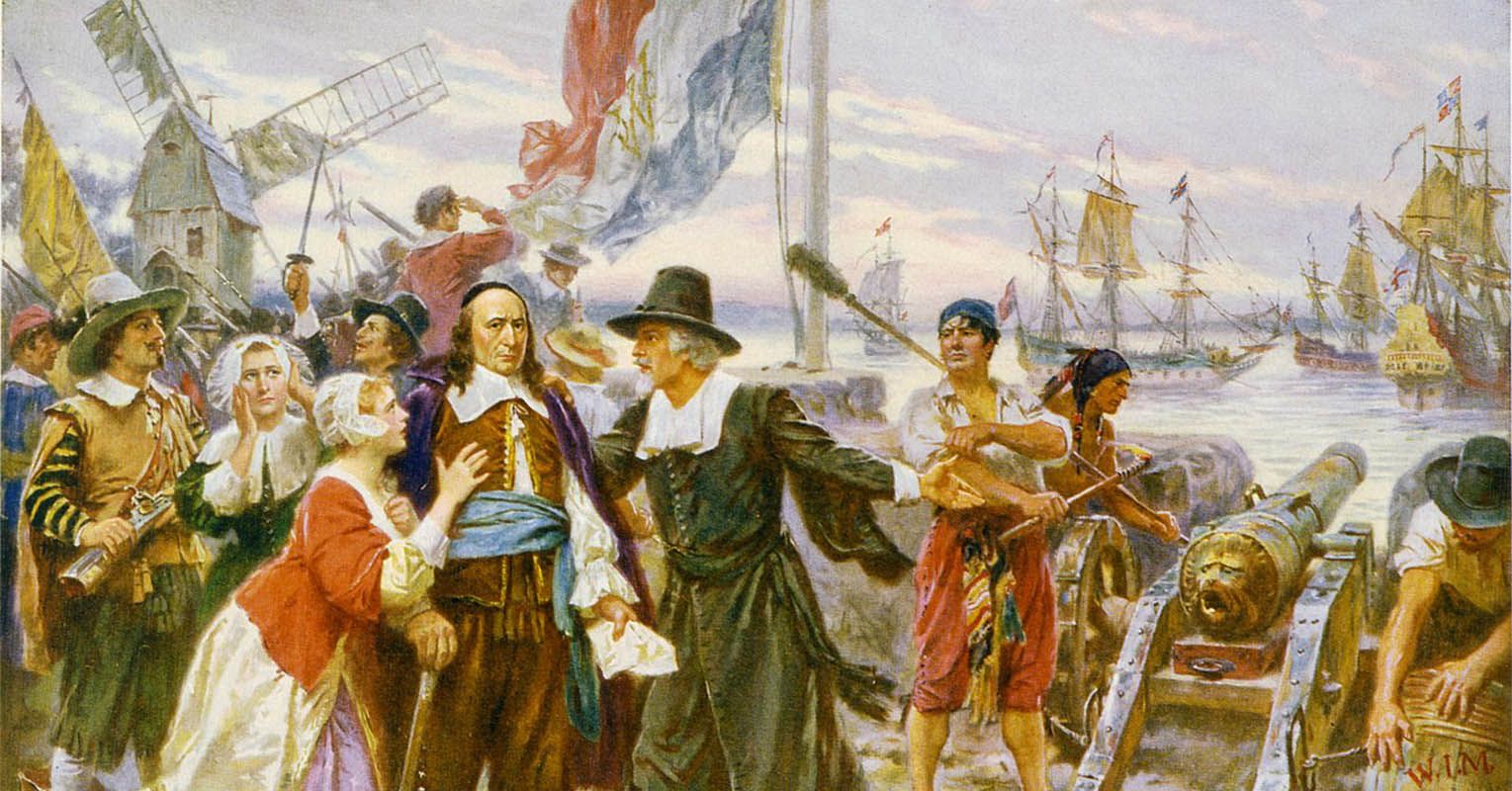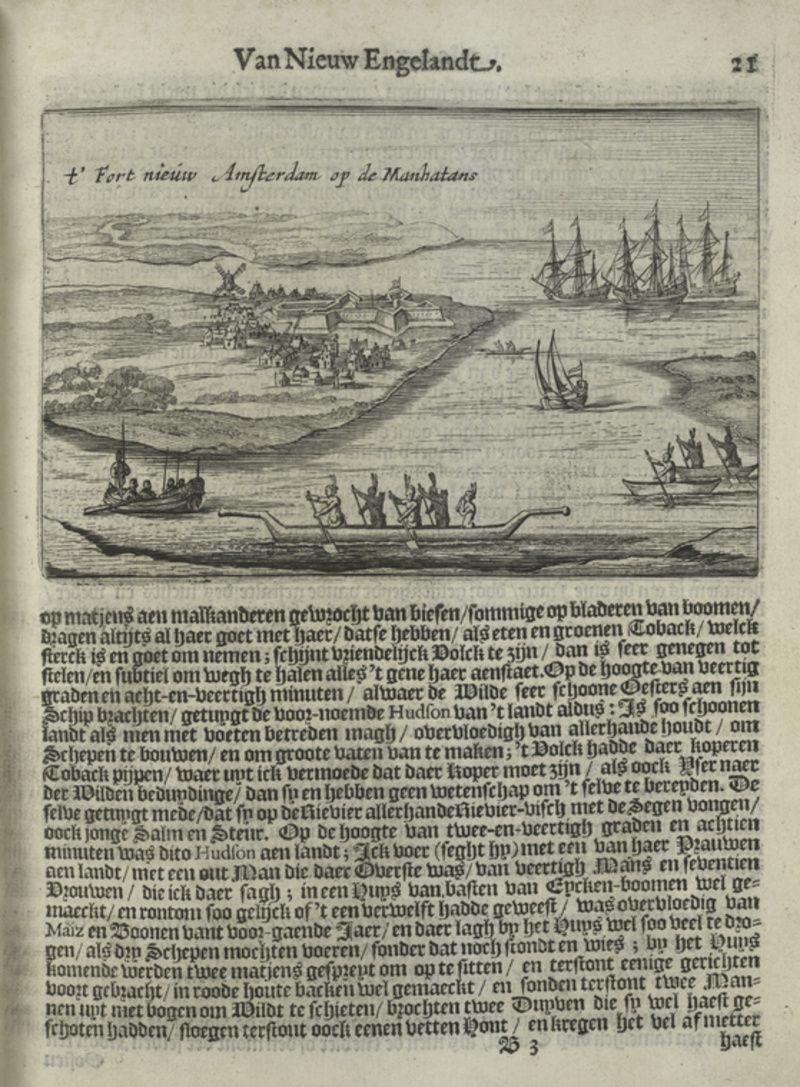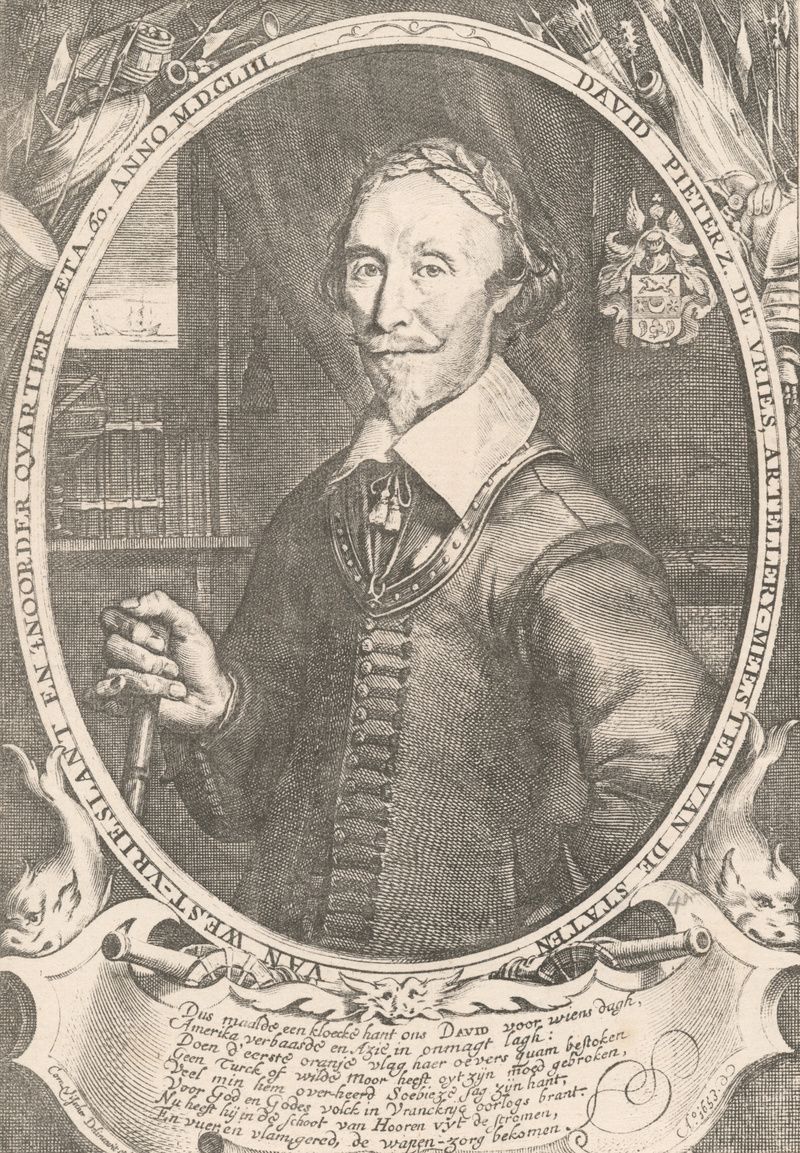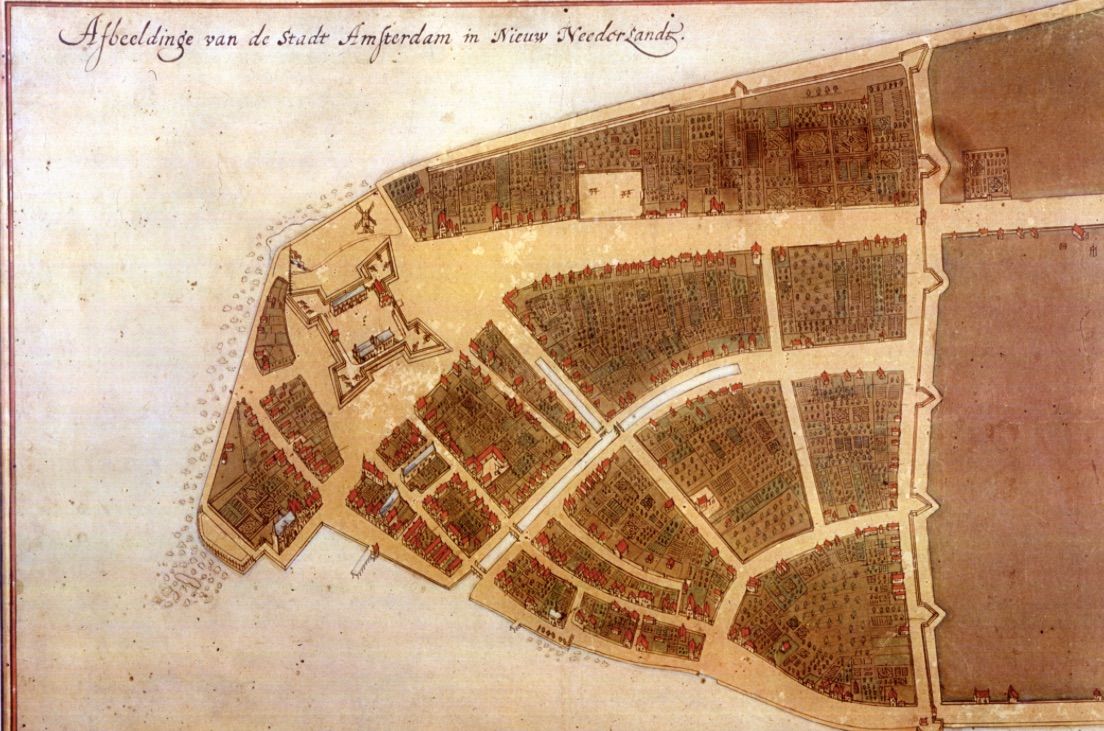10 Giant Menorahs That Will Light Up for Hanukkah in NYC
From Brooklyn to the Bronx, we’ve rounded up the most exciting giant menorahs that will light up throughout the next eight evenings!


Untapped New York is excited to announce a new editorial collaboration with the Gotham Center for New York City History. In this series, we’ll share fascinating stories from the Gotham Center archives. These scholarly articles will explore New York City history through a variety of lenses and cover topics that range from Dutch colonialism to modern art!
In the initial instructions to New Netherland’s director general regarding obtaining land from Indigenous peoples, the Dutch West India Company leadership wrote: “For trading-goods or by means of some other amicable agreement, induce them to give up ownership and possession to us, without however forcing them thereto in the least or taking possession by craft or fraud, lest we call down the wrath of God upon our unrighteous beginnings, the Company intending in no wise to make war or hostile attacks upon any one.”[1]
The Dutch knew that Europe was watching as they began colonial ventures in North America, and they wanted to set themselves apart from the horrors of bloody conquest and slavery that made up the Black Legend of Spanish colonization. They were determined to set a better example by relying on a legal tradition that acknowledged Indigenous sovereignty instead of taking land by force. Moreover, they deployed capitalism to establish a foothold in North America, engaging in what they believed was mutually beneficial trade as a means of acquiring land from its rightful owners, and these purchases were all to be legal and above board, documented in land titles and letters shared with the governing bodies of the West India Company and the United Provinces.
From these policies, we get Manhattan’s famous origin story: the Dutch bought what would become a great metropolis for trinkets and beads. This story is often recounted in a way that naturalizes the English conquest in 1664: the Dutch were skilled traders, acquiring Manhattan for a song, but then didn’t have the good sense to take the steps required to hold on to it. But it’s also a story that legitimizes the colonial occupation of Native space on which New York City stands.[2] Neither Dutch nor Indigenous peoples “knew” that they were living on some of the most valuable ground on earth, as the story goes.

Yet this story, for the Munsee-speaking peoples who lived on and around Manhattan, was neither a beginning nor an end. Historians such as William Cronon and, more recently, Lisa Brooks, have revisited early land deeds from neighboring New England from the perspective of seventeenth-century Indigenous cultures, and they have collectively found that the land-as-capital model that the Dutch and English brought with them from Europe did not hold up in the Americas.[3] Native nations saw land as a space to live and hunt and cultivate, not as an object to be bought and sold. What Munsee peoples traded for sixty guilders was access to Manhattan, not a transfer of ownership from Indigenous to settler.
After the “purchase,” and the subsequent settlement of parts of Manhattan by Dutch colonists, the region’s Indigenous population continued to use the land much as they had before. They planted maize fields, with beans winding up the supportive corn stalks. They fished and scoured the beaches for clams and oysters, and in the winter, they moved inland to hunt. On Long Island, they made wampum from Quahog clams, which the Dutch appropriated into a currency.
The fundamental misunderstanding embedded in the “purchase” of Manhattan quickly began to strain relationships between the Munsee villages and the newcomers. The colonists and their livestock trampled maize fields and disrupted Munsee livelihood, to which they responded by killing cattle and hogs. The Dutch retaliated with violence, at times murdering Indigenous villagers, their acts often a severe escalation.[4] The seeds of this cyclical conflict had been sown in the original “sale.” In the very act that was supposed to promote peace in their new colonial settlements, the Dutch had ensured that the region’s Munsee population would become increasingly frustrated until violence against the symbol of Dutch presence on the land — livestock — became their only outlet. The settlers responded by rethinking their supposedly benevolent policies of trade and respect for Indigenous sovereignty.
After visiting neighboring Plymouth, colonist Isaak de Rasieres noted in a letter that “The tribes in their neighborhood… are better conducted than ours, because the English give them the example of better ordinances and a better life; and who also, to a certain degree, give them laws, in consequence of the respect they from the very first have established amongst them.”[5] The key to improving Dutch-Munsee relations, in De Rasieres’ view, was to demonstrate justice through good governance and, significantly, to subject Munsees “to a certain degree” to Dutch law. In essence, he felt the Dutch had treated the Munsee villages too much like sovereign entities and should instead have commanded greater “respect… from the very first.” A few years later, New Netherland’s new director general, Willem Kieft, would return to the idea of subjecting Munsee peoples to Dutch law, with disastrous consequences.

The war that the West India Company hoped to avoid through land purchases did eventually come, less than two decades after the Dutch “bought” the island. Kieft made increasing demands of the Munsee residents of Long Island, Manhattan, and Staten Island. He felt that the local Indigenous population took advantage of New Amsterdam, by continuing to live in their nearby villages, plant their corn, and use the fishing grounds in spaces that Kieft ostensibly viewed as being “owned” by the Dutch. In late 1639, he enacted a two-pronged policy aimed at correcting what he viewed as an imbalance of power on Manhattan. To reset trade relations, he fixed maize prices to make them more favorable to the Dutch.[6] Further, he made the fateful decision to demand tribute to pay for fortifications, citing what he considered the mutual defense that such structures provided.[7] He sought to use the tribute to bring the “savages” into “obedience” and chose to implement his ordinance by force.[8]
Munsee villagers refused to submit to Kieft’s unreasonable demands, and, eventually, the Indigenous population retaliated with murder, killing the Dutch settler Claes Swits, a wheelwright. Before deciding how to proceed, Kieft and the council called upon twelve men, all heads of households of different professions, to weigh in on the wartime strategy. This polling of the twelve men was a key moment in the conflict, and it demonstrates that the Dutch considered their options and chose a path by consulting with a representative sample of New Amsterdam’s colonists. The choices they made can therefore be said to more or less reflect the perspectives of the whole settler community. The director asked them whether, if the Munsee people refused to surrender the individual responsible for the crime, it would be “just” to destroy their entire village. Their replies ranged from cautiously opposed to outright genocidal:
Jochim Petersz said that it would be best to stay patient and “rock the savages to sleep.” Jan Eversen agreed.
Jacques Bentijn preferred to kill the “savages” in order to terrorize them.
Jacob Stoffelsen, George Rapalje, Gerrit Dircksz, and Hendrick Jansen wanted to wait for a ship from the Fatherland to arrive before deciding what to do.
Abraham Pietersz argued that they should begin a war against the “savages,” which would make it possible to “exterminate” them.
Frederick Lubbersen did not believe they could successfully execute a war, and Jacob Waltingen agreed to go along with whatever the director and council thought was best.[9]
Later, after the war, colonist David de Vries argued that the twelve men did not consent to the initial attacks. The twelve men’s replies, summarized and quoted here, certainly demonstrate an uneasiness about immediately destroying a village, given the possibility that the Dutch may not have the men and means necessary to win a prolonged conflict at that time. Nonetheless, their words convey general support for the idea of war and a willingness to massacre innocent people to achieve their ends. None of the twelve men responded to Kieft’s question by saying that it would be unjust to destroy an entire village as retribution for Swits’ murder.

The more bellicose voices ultimately prevailed, and the war that followed was vengeful and horrific, yet always written about in a manner that, the director and council assumed, was justified under Dutch law. The council’s resolutions ordering new attacks or rewards for the heads of “enemies” always began with a recounting of a list of grievances against the Munsees, such as cattle and settlers killed. They were careful to ask that women and children be spared, or that only the heads of “murderers” be severed. These gestures toward legality obscured the exterminationist tactics and vicious anger that fueled much of the war. In 1643, after one such accounting of grievances, the New Amsterdam council resolved that they would become “slaves” to their indigenous neighbors if they did not act quickly and destroy neighboring villages.[10]
After years of violence and with stories of Dutch massacres circulating through the region, local villages began to surrender and form unsteady alliances with the settlers. One peace negotiation reveals how Munsees interpreted the war and its origins. The assembled leaders got right to the heart of the conflict, acknowledging that losing the war would mean physical separation, a recognition of Dutch ownership of Manhattan, and an acceptance of the colonial interpretation of the land. In the council minutes, the colonists recorded that the leaders promised to: “now and forever, in the territory of New Netherland, do no harm to any people, livestock, houses, or anything else.” Moreover, they agreed to no longer come to the island of Manhattan as long as the Dutch were at war with any Native peoples, except by canoe before the fort. They added that they would do their best to obtain Dutch permission — a “pass” — before making such a trip. The terms of peace underscored the war’s origins in a struggle over access to and, ultimately, possession of land.[11]
Kieft’s War was the seed from which New York grew. It was the starting point for everything that the colony became, but the origins of the war stretched back before Willem Kieft ever set foot on the island of Manhattan. The kernels of it were there in that “sale,” the supposed buying of a place that could not be bought. The beginnings of his war were in the belief that the laws of Europe had jurisdiction over North America, and that capitalist valuation of land could be imposed upon Native space.
The part of New York’s origins that we no longer want to acknowledge as the source of the story’s popularity is the accounting, the sparse number of goods exchanged for an entire island. It’s the supposed cleverness and foresight of the Dutch purchasers that have made this a tale worth telling, always with a bit of a sneer, a subtle recognition that the settlers didn’t actually believe their own claims that they met the Munsee as equals.

When Munsees realized over time that the Dutch wanted more than just shared access to the land and its resources, they responded with reassertions of their sovereignty. They refused to pay Kieft’s tributes, and refused to be subjugated. At times, they retaliated with violence, killing a settler or his livestock.[12] It was this behavior that Kieft claimed was disobedient, that needed to be tamed and brought under control. It was this behavior — the Munsee demand that they be treated as autonomous, as equal — that the council interpreted as being “delusional” and akin to enslaving the colonists.
Perhaps if we told New York’s origin story as it really was, in more words than can fit in a single sentence, we would no longer think of it as such a good origin story. Rather than a tale that emphasizes a colony’s legal and righteous beginnings, it would become just one of many American stories of Indigenous dispossession, of violence, and loss. Or perhaps we would shake it off as a sad incident that happened a long time ago, and something that can’t be changed now, anyway: a dodge we so commonly deploy when confronted with the violent reality of the past. The story, when stripped of its mythology, loses its potency.
Or maybe this origin story’s usefulness doesn’t depend on myth-making at all. It is a cautionary tale that starkly demonstrates how the foundations of a community cannot rest on falsehoods and misunderstanding. In the end, the power of a good origin story doesn’t come from an affirmation that we are — and have always been — clever, just, and wise, but lies instead in its ability to encourage us to reckon with the past as a means of aspiring to something better.
Erin Kramer is an Assistant Professor of History at Trinity University. She is working on a manuscript titled The Ancient House: Constructing Community in the Seventeenth-Century New York Borderlands.
Next, check out 10 Streets from the Colonial Street Grid and read more from the Gotham Center blog here!
Sources
[1] The instructions to Willem Verhulst, and the purchase of Manhattan, were discussed in a 2012 post on the Gotham Center blog by Richard Howe. https://www.gothamcenter.org/blog/notes-on-the-manhattan-purchase.
[2] Benjamin Schmidt, Innocence Abroad: The Dutch Imagination and the New World, 1570-1670 (New York: Cambridge University Press, 2001).
[3] William Cronon, Changes in the Land: Colonists and the Ecology of New England (New York: Hill & Wang, 1983) and Lisa Brooks, The Common Pot: The Recovery of Native Space in the Northeast (Minneapolis: University of Minnesota Press, 2008).
[4] David de Vries describes one such horrific incident during Kieft’s War when a group of colonists massacred a Raritan village on Staten Island in retaliation for the killing of livestock. See “Notes of David de Vries” in Narratives of New Netherland, edited by J. Franklin Jameson (New York: Scribner, 1909), 208-09.
[5] Isaak de Rasieres to Samuel Blommaert (ca. 1628) in Narratives of New Netherland, 113.
[6] New York State Archives, Dutch Colonial Council Minutes, 1638-1665, Series A1809-78, Vol. 4, p. 50, Order, September 22, 1639, Box 1, Folder 5.
[7] New York State Archives, Dutch Colonial Council Minutes, 1638-1665, Series A1809-78, Vol. 4, p. 49, Order, September 15, 1639, Box 1, Folder 5.
[8]“Soo ist dat wy derhalven geresolveert hebben een Chaloup met Soldaten dewaerts te Senden omme de selve wilden onder onse gehoorsaemheyt ende contributie te brengen.” New York State Archives, Dutch Colonial Council Minutes, 1638-1665, Series A1809-78, Volume 4, p. 73, Resolution, August 9, 1640, Box 1, Folder 8.
[9] “Rock the savages to sleep”: “de wilden in slaep te wiegen”; “kill the savages… to terrorize them”: “wesen de wilden doot te slaen, om de vrees haer aen te jagen”; “possible to exterminate them”: “de wilden uyt te roden soot doenl[ijk] is.” New York State Archives, Dutch Colonial Council Minutes, 1638-1665, Series A1809-78, Vol. 4, p. 104, Proposals, November 1, 1641, Box 1, Folder 11.
[10] “Ja haer genochsaem inbeeldende of wy hier gecomen waren om haer slaven te sijn.” (“Yes, they were sufficiently delusional to imagine that we came here to be their slaves.”) New York State Archives, Dutch Colonial Council Minutes, 1638-1665, Series A1809-78, Volume 4, p. 161-162, Resolution, February 27, 1643, Box 1, Folder 17.
[11] “de vreede wilde versoeken, alwaer sy belooft hebben, nu noch ten Ewigen dagen int gebiet van Nieu nederlandt, alle menschen, vee, huysinge, ofte iets anders, enich quaet te doen, meede dat sy soo lange als wy nederlanders in Oorloch sijn, met andere heydenen opt Eylant Manhatans, niet sullen comen, ten ware met een cano tot voort fort Amsterdam, beloven meede haer best te sullen doen om ons pacha op te soeken.” New York State Archives, Dutch Colonial Council Minutes, 1638-1665, Series A1809-78, Vol. 4, p. 186-87, Proposals, March 31, 1644, Box 1, Folder 19.
[12] Readers interested in learning more about Munsee experiences of Dutch and English colonization should consult: Andrew Lipman, The Saltwater Frontier: Indians and the Contest for the American Coast (New Haven: Yale University Press, 2015); Mark Meuwese, Brothers in Arms, Partners in Trade: Dutch-Indigenous Alliances in the Atlantic World, 1595-1674 (Leiden: Brill, 2012); Paul Otto, The Dutch-Munsee Encounter in America: The Struggle for Sovereignty in the Hudson Valley (New York: Berghahn Books, 2006).
Subscribe to our newsletter